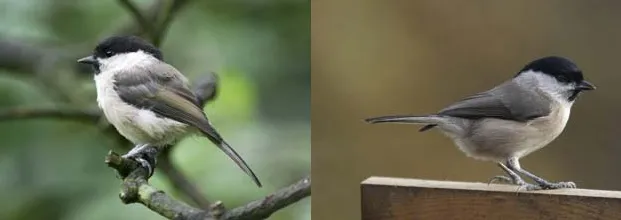Are marsh tits and willow tits the same species?
Willow tits and marsh tits are easily confused, even by the best birders. In fact, they are so similar that the willow tit was the last regularly breeding British bird to be identified and named in 1897, before that there were only marsh tits. The best way to tell them apart is by their calls. A willow tit has a ‘zee-zurzur-zur’ call whereas a marsh tit call sounds like ‘pitchou’.
How to tell the difference between a willow tit and a marsh tit?
The pair are very similar in appearance and the differences between them are subtle and sometimes overlapping. The only obvious distinguishing features are the pale edges on some of the willow tit’s flight feathers, which give the appearance of a lighter wing panel, and the pale spot at the base of the upper mandible in the marsh tit – this species also has a more obvious pale cutting edge to the mandibles.
The black cap of marsh tits is glossier than that of willow tits, and doesn’t extend as far down the nape. Willow tits have larger and less defined bibs than marsh tits, and also have pale cream edges to the wing feathers, which gives the appearance of a pale wing panel when the wings are closed.
The calls and songs are diagnostic, however: the marsh tit’s call is an explosive, sneezing ‘pitchou’ – sometimes ‘pitchou-dee-dee-dee-dee’; the willow tit’s is a nasal-sounding ‘zee-zur-zur-zur’. And while the marsh tit’s song is a rapid, ringing ‘swe-swe-swe-swe-swe-swe’, that of the willow tit is a slow, melancholy ‘tsui-tsui-tsui-tsui’.
When are you most likely to see them?
Rare, but welcome, visitors to gardens, marsh tits and willow tits are most likely to appear in the winter when food in the wider countryside is scarce. During the summer they rely on insects and spiders, but during the colder months beech mast and other tree seeds become important. Marsh tits will also take some nuts and berries

Willow tit (left) and marsh tit (right) are hard to tell apart but the latter has a glossier cap. © Gray Images/BTO, Jill Pakenham/BTO
Marsh tit vs willow tit: habitat
Despite their name, marsh tits prefer drier habitats and are most commonly found in large areas of broadleaved woodland, especially those with a well-developed shrub layer. Willow tits are associated with damper areas, including wet woodland. Both species are absent from Ireland, the Isle of Man, and much of Scotland, although the willow tit breeds further north in Scotland than the marsh tit.
Marsh tit vs willow tit: nests
Both species nest in holes, typically in rotten stumps. Willow tits excavate their own holes, preferring birch, willow or alder. Marsh tits, however, only enlarge other holes, often taking over willow tit holes. Marsh tits also hold very large territories, typically three times larger than that of great tits.
Marsh tit vs willow tit: threats
Both willow tits and marsh tits are IUCN red listed species due to their declining populations. Willow tits are now locally extinct in many areas, particularly in the southeast, and the numbers of both species have been falling since the 1970s. This decrease is most likely due to the deterioration of quality woodlands and the loss of understorey vegetation.
Marsh tit © Jill Pakenham/BTO
